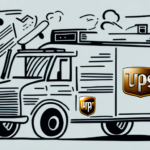Understanding UPS Shipping Rates for Textbooks
As a textbook seller, comprehending shipping rates is crucial for optimizing your business operations. Shipping costs can significantly influence your profit margins and overall customer satisfaction. UPS stands out as one of the most reliable carriers for shipping textbooks. In this article, we will explore the various factors that influence UPS shipping rates for textbooks and provide guidance on how to calculate these costs effectively.
Why Shipping Rates Matter for Textbook Sellers
Shipping rates play a pivotal role in the textbook selling business. Customers expect reliable and timely deliveries at competitive prices. If shipping costs are too high, potential buyers may abandon their shopping carts or switch to competitors offering better rates. Conversely, undercharging for shipping can erode your profit margins and make it challenging to cover shipping expenses.
- Customer Retention: Competitive shipping rates enhance customer satisfaction and loyalty.
- Profit Margins: Accurate shipping costs ensure that your business remains profitable.
- Market Competitiveness: Offering optimal shipping rates can give you an edge over competitors.
To strike a balance between shipping costs and customer satisfaction, consider implementing strategies such as offering free shipping for orders above a certain threshold. This approach can encourage customers to purchase more items, thereby increasing your revenue and mitigating the cost of free shipping. Additionally, you can negotiate shipping rates with UPS or explore alternative shipping options to identify the most cost-effective solutions for your business.
Moreover, it's essential to consider the environmental impact of your shipping practices. Utilizing eco-friendly packaging materials and partnering with carriers committed to sustainability can help reduce your carbon footprint. These measures not only contribute to environmental preservation but can also attract environmentally conscious customers.
The Benefits of Using UPS for Shipping Textbooks
UPS is renowned for its reliability and extensive range of shipping options tailored to meet diverse business needs. Whether you require ground shipping for cost-effectiveness or expedited services for urgent deliveries, UPS offers solutions that ensure your textbooks reach their destination promptly and securely.
- Comprehensive Tracking: UPS provides detailed tracking information, allowing both you and your customers to monitor shipments in real-time.
- Variety of Packaging Options: UPS offers specialized packaging materials, including boxes and envelopes designed to protect textbooks during transit.
- Sustainability Commitment: UPS emphasizes carbon-neutral shipping options and eco-friendly practices, aligning with environmentally responsible business operations.
According to UPS, businesses that utilize their shipping services experience a 30% reduction in delivery-related issues, enhancing overall customer satisfaction (UPS Commitment).
How UPS Determines Shipping Rates for Textbooks
UPS calculates shipping rates based on several key factors:
- Package Weight and Size: Heavier and larger packages incur higher shipping costs due to increased transportation expenses.
- Destination: The distance between the origin and destination affects the shipping rate, with longer distances typically costing more.
- Shipping Service: The chosen shipping speed (e.g., ground, expedited) influences the overall cost.
- Package Type: Specialized items, such as textbooks, may qualify for discounted rates, especially if shipped by educational institutions or bookstores.
Additionally, UPS may offer special rates for bulk shipments to educational institutions, further reducing costs for textbook sellers. It's advisable to consult directly with UPS or your shipping provider to explore available discounts and tailor shipping solutions to your specific needs.
Factors That Affect UPS Shipping Rates for Textbooks
Beyond the primary factors of weight, size, and destination, several additional elements can influence UPS shipping rates:
- Fuel Surcharges: These are additional fees to account for fluctuating fuel prices, impacting overall shipping costs.
- Additional Handling Charges: Larger or irregularly shaped packages may incur extra fees to cover specialized handling requirements.
- Residential Delivery Fees: Delivering to residential addresses often costs more than to commercial locations due to the logistical complexities involved.
- Shipping Speed: Expedited services like next-day or two-day delivery come at a premium compared to standard ground shipping.
- Package Value: High-value textbooks may require additional insurance, increasing the total shipping cost.
Understanding these factors enables you to make informed decisions when selecting shipping options, ensuring cost-efficiency without compromising service quality.
For a comprehensive overview of UPS shipping rates, refer to the official UPS Shipping Rates Guide.
How to Calculate UPS Shipping Rates for Textbooks
Calculating UPS shipping rates for textbooks involves the following steps:
- Determine the weight and dimensions of your package.
- Identify the destination ZIP code where the textbook will be shipped.
- Select the desired shipping service (e.g., UPS Ground, UPS Next Day Air).
- Use the UPS Rate Calculator on the UPS website to input these details and obtain an accurate shipping quote.
Alternatively, employing a shipping calculator tool can automate this process, saving time and minimizing the risk of human error. Remember to account for any additional services, such as insurance or signature confirmation, which may affect the final shipping cost.
UPS offers a variety of shipping services tailored to different needs:
- UPS Ground: A cost-effective option for non-urgent shipments with delivery times typically ranging from one to five business days.
- UPS Next Day Air: Expedited service for time-sensitive deliveries, ensuring next-day delivery.
- UPS 2nd Day Air: Guarantees delivery within two business days.
Choosing the appropriate shipping service depends on your budget, delivery timeline, and the specific needs of your customers.
Tips for Reducing UPS Shipping Costs for Textbooks
Minimizing UPS shipping costs while maintaining service quality is achievable through several strategies:
- Negotiate Rates: If you are a high-volume shipper, negotiate discounted rates with UPS to lower your overall shipping expenses.
- Use Flat-Rate Shipping: UPS offers flat-rate boxes that allow you to ship packages of specific sizes and weights for a fixed price, regardless of the destination.
- Consolidate Shipments: Bundling multiple small packages into a single shipment can result in significant savings.
- Leverage Online Shipping Tools: Utilize online platforms that provide discounted UPS rates, such as the official UPS Online Shipping tool.
- Smart Pickup Service: Schedule pickups at your convenience, reducing the need for trips to UPS locations.
- Efficient Packaging: Properly packaging your textbooks with sturdy materials can prevent damage and avoid additional fees related to overpacking or inadequate protection.
Implementing these tips can help you achieve substantial savings on UPS shipping costs while ensuring that your textbooks reach customers in excellent condition.
Comparing UPS Shipping Rates to Other Carriers for Textbooks
While UPS is a leading carrier for shipping textbooks, it's essential to compare its rates with other carriers to ensure you're securing the best possible deal. Factors to consider when comparing include:
- Cost: Analyze the base shipping rates and any additional fees or surcharges.
- Delivery Time: Compare the estimated delivery times offered by different carriers to meet your customers' expectations.
- Reliability: Assess the reliability and track record of each carrier in terms of on-time deliveries and package handling.
- Tracking and Support: Ensure that the carrier provides comprehensive tracking information and reliable customer support.
Utilize resources like Shippo or other shipping comparison tools to evaluate different carriers such as FedEx, USPS, and DHL against UPS.
Additionally, consider factors like package restrictions, bulk shipping discounts, and the availability of specialized services that may better suit your specific shipping needs.
Understanding the Different UPS Shipping Options for Textbooks
UPS offers a variety of shipping options to accommodate different needs and budgets:
- Ground Shipping: Provides reliable delivery within one to five business days, suitable for non-urgent shipments.
- Air Shipping: Includes options like UPS Next Day Air and UPS 2nd Day Air for faster delivery times.
- International Shipping: Tailored solutions based on destination country regulations and customs requirements.
In addition to these primary services, UPS offers several supplementary services:
- Signature Confirmation: Ensures packages are delivered only to the intended recipient.
- Insurance: Protects high-value shipments against loss or damage during transit.
- Package Tracking: Provides real-time updates on the status and location of shipments.
These options enhance the security and reliability of your textbook deliveries, providing peace of mind for both you and your customers.
How to Choose the Right UPS Shipping Option for Your Textbooks
Selecting the appropriate UPS shipping option depends on several factors:
- Package Size and Weight: Larger and heavier packages may be more cost-effective with ground shipping.
- Delivery Timeline: Assess the urgency of the shipment to choose between standard and expedited services.
- Destination: Consider whether the shipment is domestic or international, as this will influence the shipping method and cost.
- Value of Textbooks: High-value shipments may benefit from additional insurance and tracking services.
For instance, if you need to ship a bulk order of textbooks to a university campus with no time constraints, UPS Ground would be a cost-effective choice. However, for urgent orders requiring overnight delivery, UPS Next Day Air would be more appropriate.
Additionally, selecting shipping options that include detailed tracking and insurance can safeguard valuable shipments, ensuring they reach their destination safely and providing both you and your customers with assurance.
Proper packaging is also critical. Use durable boxes and protective materials to prevent damage during transit. UPS offers a range of packaging supplies and services to help ensure your textbooks are securely packaged.
Common Mistakes to Avoid When Using UPS to Ship Textbooks
When utilizing UPS for shipping textbooks, avoiding common pitfalls can enhance your shipping efficiency and customer satisfaction:
- Incorrect Labeling: Ensure that all packages are accurately labeled with the correct address information to prevent delivery delays or lost shipments.
- Inaccurate Weight and Measurements: Accurately weigh and measure your packages to avoid unexpected fees or failed deliveries due to size and weight discrepancies.
- Poor Packaging: Use sturdy boxes and adequate padding to protect textbooks from damage during transit.
- Choosing Inappropriate Shipping Methods: Selecting a slower shipping method to save costs when quicker delivery is necessary can lead to dissatisfied customers.
By addressing these areas, you can streamline your shipping process, reduce costs, and enhance the overall customer experience.
Tips for Packing and Labeling Your Textbooks When Using UPS
Proper packing and labeling are essential for ensuring your textbooks arrive in pristine condition:
- Use Durable Packaging: Select sturdy boxes or envelopes specifically designed for books to provide adequate protection.
- Cushioning: Fill empty spaces with cushioning materials like bubble wrap or packing peanuts to prevent shifting and potential damage during transit.
- Accurate Labeling: Clearly print and attach shipping labels to each package, ensuring all information is legible and correctly positioned to avoid misdelivery.
Additionally, consider utilizing UPS's packaging services, which offer a range of packaging solutions to meet your specific shipping needs. Proper packaging not only protects your textbooks but also helps in avoiding additional shipping fees related to inadequate packaging.
Conclusion
Understanding and effectively managing UPS shipping rates is essential for any textbook seller aiming to optimize their business operations. By comprehensively grasping the factors that influence shipping costs, accurately calculating expenses, and comparing rates with other carriers, you can significantly reduce shipping expenses while maintaining high levels of customer satisfaction. Implementing the provided tips and avoiding common mistakes will streamline your shipping process, ensuring your textbooks are delivered safely and on time, ultimately contributing to the success and growth of your business.






















